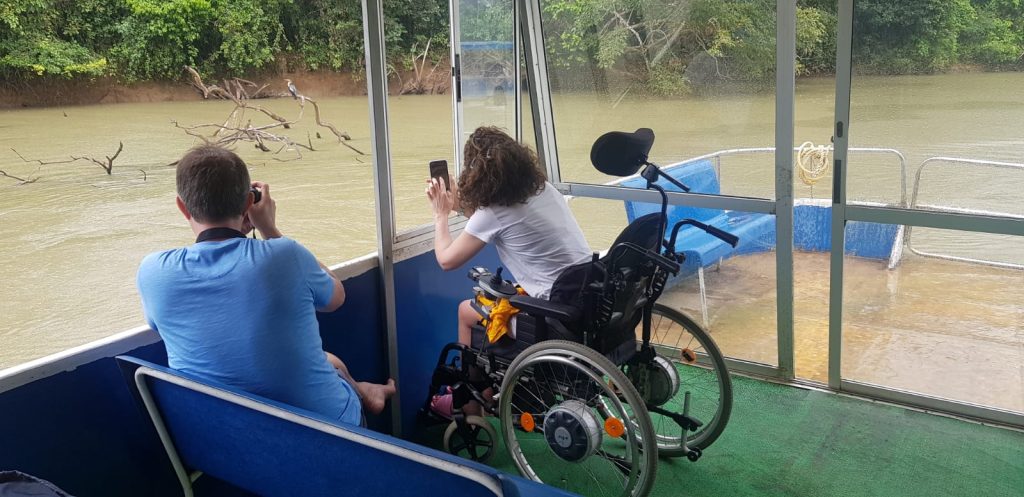It’s one of the iconic images of Costa Rican tourism: a happy traveler flying through the rainforest canopy on a zipline. Whether they’re canyoning, rafting, tubing, or getting their adrenaline fix another way, more than 61% of visitors to Costa Rica reported having tried adventure travel during their stay, according to a 2019 study by the Institute of Costa Rican Tourism (ICT).
Adventure is a huge part of how Costa Rica markets itself—but those dramatic photos often feature young and able-bodied tourists.
Are Costa Rica’s adventures accessible for people who don’t fit that stereotype, including senior citizens and people with disabilities?
Yes.
Absolutely.
The answer received by El Colectivo 506 by veteran tour guides Luis Diego Soto and Juvenal Acuña Sánchez, both members of the Costa Rican Accessible Tourism Network, is direct and simple.

“I tell people, my recommendation is that they come to Costa Rica,” says Luis Diego Soto, who has worked in the tourism sector for 32 years. “Come and experience everything this country is, in an accessible way.”
Both Luis Diego and Juvenal, who has been a tour guide since 1997, say that despite the way that adventure tourism is sometimes presented, Costa Rica’s most exciting experiences are open to all. While travelers who need special accommodations need to seek out qualified tourism providers such as these Accessible Tourism Network members, who have the expertise and equipment to provide universal accessibility, Juvenal and Luis Diego emphasize that adventure awaits for absolutely anyone.
Their most important advice to any traveler seeking adventure? Be honest and up front about your needs. This goes for absolutely anyone, whether you’re 10 or 100.
“It’s important for everyone to know that all tour operators and agencies will have their waivers, their forms to liberate them from responsibility,” says Juvenal. He adds that these forms—which tend to ask about surgeries, heart issues or high blood pressure, shouldn’t be seen as a limitation—but as an opportunity to be totally transparent about needs so providers can serve you better. “They need to fill out the form honestly, because if there’s any untruth there and something happens, big problems can result.”
And, of course—when filling out forms like that, but also at every stage in planning your trip—it’s important to think through needs that might not be summed up in a checkbox. For example, if hiking is planned, think through the length you’d like to walk, when you’d like to rest, the difficulty level you’d like to see—and communicate that up front so that your guide neither over- nor underestimates your capacity.
As we noted in our previous story on the Accessible Tourism Network, the planning and equipment needed to make some adventures possible can be vast. However, these two guides say it’s worth it, hands down, whether a traveler needs a patient transfer device or amphibious wheelchair, or just a railing to grab here and there. (Pro tip from Juvenal: if there’s any chance you’d benefit from a walking stick or other support, err on the side of preparedness—because in Costa Rica’s forests and jungles, it can be downright hazardous to grab onto a random vine or tree branch without knowing what substances, surfaces and wildlife it might contain!)
Accessible travel in Costa Rica: what tourists (and travel providers) should know
The rewards are immense.
“There are so many beautiful stories,” says Juvenal. “Taking someone with a motor disability, who can’t walk, into the forest and having her hug a tree—and watching her cry from happiness. They say, ‘Never in my life did I think I could access a forest like that.’”
“There was the time a lady from Spain did a canopy [zipline] for the first time, and when we got to the end she hugged me, crying, because she had never felt the freedom of not being in a wheelchair,” says Luis Diego. He adds that doing forest tours with the visually impaired is another wonderful experience because the soundscape is so intense that it allows them to create an image in their minds. “I’ve had the opportunity to have people with visual disabilities tell me, ‘Everything looks so beautiful.’”
He points out that one aspect of Costa Rican culture that sometimes gets overlooked or disparaged, its gastronomy, is sometimes another star of an accessible tour. Food brings everyone together, and is often a favorite memory of his visitors.

These veteran guides say that their years of adapting tours for senior citizens with diverse needs, and people with disabilities, has changed them—and should keep changing their country.
“There are lots of things that have been hard, but we’ve been overcoming those obstacles, little by little,” says Juvenal. “We need to help tour operators and travel agencies understand that this is a very important kind of tourism.
“I’ve become more humble, and realized that sometimes we complain too much about things when actually, we have it all,” he continues. “This is a real school of life. I’ve learned to be grateful: grateful for what I have, grateful for what I do, grateful that, thanks to me, a lot of people fall in love with this country.”

We are grateful for the support of Travel with Ann Experiential for the travel content in our January and February editions. Ann Becker has been a small business owner throughout her career. With more than three decades of experience in meeting/event management and strategy consulting combined with a passion for travel rooted in deep, mutually beneficial human encounters, in 2005 she began Travel with Ann Costa Rica. For 15 years she created and led more than 40 small group experiential trips in Costa Rica, neighboring countries, and Chile. Today, through Travel with Ann Experiential , Ann is dedicated to supporting and strengthening responsible travel small businesses, nonprofit organizations and industry leaders by forging strategic connections; contributing fresh perspectives; engaging and elevating diverse voices; and strengthening organizational capacity.







